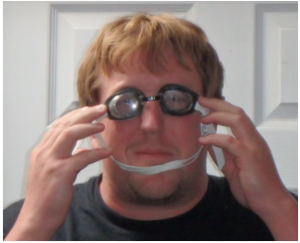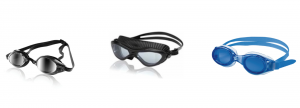Written by Eric W., Making Waves Swim Instructor
Everything You Need to Know About Goggles
…and possibly something you don’t want to know too.
Goggles, goggles, goggles. What are they? How do they work? What size should I get? What kind should I get? What brand should I get? Do I or my child even need them? And why oh why do my goggles keep fogging up? Keep reading for answers on these questions and more.
What are goggles and how do they work?
Goggles or more specifically “Swim Goggles” are equipment designed to create an air pocket in front of the eyes. Our eyes are poorly adapted to see clearly underwater due to the shape of the human eyeball lens and how the index of refraction for light is much different though water rather than through air. Think of how a pencil looks like it’s “broken” when placed in a glass of water. Long story short, our eyes are poorly equipped to handle this change in how light behaves. Goggles bypass this problem by placing a pocket of air in front of our eyes, thus enabling us to see clearly underwater.
Do I / my child need goggles to swim?
NOPE! Goggles make swimming much more comfortable and enjoyable but for me to consider someone to be a “safe swimmer” they should be able to swim themselves to safety without them. I have seen too many children and adults go into a full panic mid pool because their goggles started leaking. Or what if you fell in the pool without them on? As an instructor, I have my beginner students start without them and then add them in later as the student becomes better adjusted to getting their eyes wet. That said, they are extremely helpful once we start swimming anything more than 10 feet at a time. Goggles will help students concentrate on their strokes by reducing distractions, improving vision, and greatening enjoyment. Most of my students do wear them. Competitive swimming? Absolutely necessary. Safety first though!
What size should I get?
Goggles generally come in “Youth” and “Adult” sizes. “Youth” generally fits up to age 8 but that is not by any means an actual “rule.” The shape of the goggle in question is a much better indicator of whether or not it will fit properly
How do I ensure my goggles fit properly?
- Find goggles with a good seal. You know you have a good seal when you can press the goggles against your eyes and they both stay there for a while. A good seal stays for a bit (top photo). A bad seal does not (bottom photo).
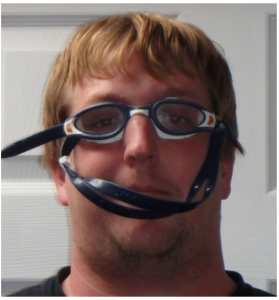
- The nose bridge. Some goggles have adjustable nose bridges (figure right), some have interchangeable nose bridges of different sizes (figure below), and others are fixed (figure left). Adjust nose bridge for optimal seal and comfort if possible.
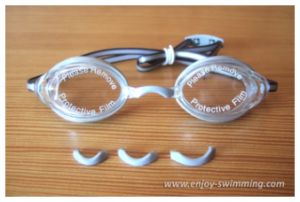
- The strap. The strap of the goggles should go around the head slightly above the ears. Straps should be snug enough to hold the goggles in place while active but not tight enough to cause discomfort. Tightening down goggles that don’t fit won’t make them fit.
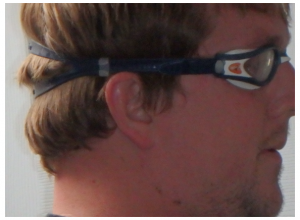
- Final notes. Step one is by and large the most important but can often be the most difficult if you don’t have a store that will let you try items on before you buy. Stores that specialize in swimming or snorkeling are more likely to let you try things out. If that’s not possible my best advice is to start with goggles that look like they would make a good seal for the swimmer in question and purchase from a retailer with a good return policy. It may take a few tries to get it right.
What brand should I get?
Any of the major brands are fine (Speedo, Nike, TYR, Aqua Sphere, etc.). A good pair of goggles should cost between $8 and $28. Anything less and don’t count on it being a good quality product. Anything more and they are stealing your money.
What type should I get?
Goggles generally come in three types:
Competitive (left): Streamlined, low air volume. Ideal for swimming lots of laps at speed. Recreational (center): Higher comfort but less streamlined. Hybrid (right): A mix of the other two.
What type is best for you? The type that makes the best seal and is most comfortable. Unless you are competitively swimming just pick the type that fits you best.
Why do my goggles keep fogging up?
Most goggles come with an anti fog coating when new but it tends to wear off pretty fast so this is a common problem. Why does it happen? Being the warm blooded mammals that we are, our faces are pretty warm. So much so that we heat up the tiny air space inside the goggles causing the humidity to condense on the cooler plastic surface of the goggles, hence, creating fog. How do we fix such an annoyance? You could buy commercial defog but, it’s expensive ($5-$10 for a small bottle), needs to be re applied each time the inside gets wet (kids tend to take their goggles on and off constantly), and can be an eye irritant if not thoroughly cleaned out after each use. Or you could do it the old fashioned way. With spit. Yes, you read that right. Get a good amount of spit in each goggle (lots), rub it around the inside, then give them a quick (really quick!!!) rinse. Convenient, inexpensive, and irritant free! Also, the more consistently you do it before swimming the better it works!
I told you that you might find out something that you didn’t want to know! But hey, at least we provided lots of beneficial goggle information with it.
Swim Safe. Swim Fast. Have Fun!
Mr. Eric W.
Making Waves Swim School Instructor

